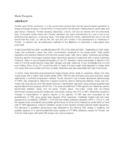Please use this identifier to cite or link to this item:
https://cris.library.msu.ac.zw//handle/11408/2846| Title: | The influence of cell wall bound calcium, cell number and size on the development of mealiness in ‘forelle’ pear.evaluation of x-ray ct and nir as non-destructive techniques for mealiness detection. | Authors: | Muziri, Tavagwisa | Keywords: | 'Forelle' pear Mealiness |
Issue Date: | 2016 | Publisher: | University of Stellenbosch | Abstract: | ‘Forelle’ pear (Pyrus communis L.) is the second most planted pear and the second highest generator of foreign exchange for pears in South Africa. It is favoured for its red blush, melting texture, sweet taste and pear flavour. However, ‘Forelle’ develops mealiness, a floury, soft and dry texture with low extractable juice. Consumers dislike mealy fruit. ‘Forelle’ mealiness has been characterized by a loss of cell to cell binding during ripening in a previous study. This study aimed to further understand the role of cell wall bound and free Ca2+, as well as the cell size and cell number in the development of mealiness in ‘Forelle’. In addition, two non-destructive methods for the detection of mealiness in intact pears were examined. It was found that free Ca2+ constituted about 49-73% of the total cell Ca2+. Depending on farm origin, mealy fruit contained a lower free Ca2+ concentration compared to non-mealy pears. Plant growth regulators and selective blossom thinning that caused larger cells had a higher mealiness percentage. Scanning electron microscopy revealed larger intercellular spaces for treatments with a higher mealiness incidence. Macro X-ray computed tomography (X-ray CT) showed a higher percentage of defects in the neck of fruit that would become mealy after storage, and after softening. To our knowledge this is a first such finding. Micro (X-ray CT) found that cells of mealy fruit were larger and ellipsoidal in shape while non-mealy cells were smaller and more rounded. Mealiness was also associated with high fruit porosity. A further study described physicochemical measurements which relate to mealiness. Mealy fruit were mostly larger with a higher total soluble solids (TSS), TSS:TA ratio and lower juice area and juice weight obtained by a confined compression method. Fourier transform near-infrared absorbance spectroscopy (FT-NIR) was employed to determine if spectra could be used to distinguish between mealy and non-mealy fruit using sensory and TSS based schemes. Classification was done using orthogonal partial least squares discriminant analysis (OPLS-DA). This study showed that FT-NIR spectra can indeed be used to discriminate between mealy and non-mealy ‘Forelle’ pears. Two–class (mealy and non-mealy) discriminant analysis produced models with accuracies ranging from 51% to 95%. Mealiness caused an increase in transmittance in specific regions of the spectra. FT-NIR was then evaluated for the quantification of TSS using partial least squares (PLS) regression. Validated models had root mean squared error of prediction (RMSEP) = 0.76-0.94 and relative prediction deviation (RPD) = 1.53-2.17, with the equator blush consistently giving better performance for three farms making the model ideal for hand held FT-NIR applications. External validation results of farm location showed reduced model robustness. The decrease in prediction performance was attributed to the differing TSS ranges in locations and possibly seasons. It is recommended that future studies on FT-NIRs calibration models for ‘Forelle’ use fruit from wide origins with wide TSS ranges over various seasons. | URI: | http://scholar.sun.ac.za/handle/10019.1/98776 http://hdl.handle.net/11408/2846 |
| Appears in Collections: | Theses |
Files in This Item:
| File | Description | Size | Format | |
|---|---|---|---|---|
| muziri abstract.pdf | Abstract | 113.94 kB | Adobe PDF |  View/Open |
Page view(s)
106
checked on Feb 26, 2025
Download(s)
36
checked on Feb 26, 2025
Google ScholarTM
Check
Items in MSUIR are protected by copyright, with all rights reserved, unless otherwise indicated.


